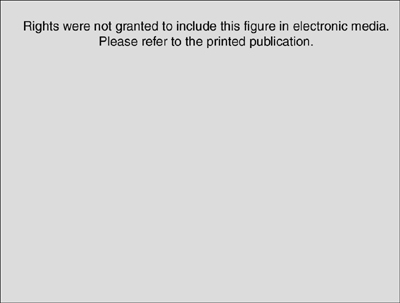Chapter 66 Heat-Related Illnesses
1 Explain the four methods of heat loss from the body
4 Why are children at a greater risk for heat-related illnesses than adults?
 Larger ratio of body surface area to mass (greater heat exchange with the environment)
Larger ratio of body surface area to mass (greater heat exchange with the environment)
 Higher set point (change in rectal temperature at which sweating starts)
Higher set point (change in rectal temperature at which sweating starts)
 Greater endogenous heat production
Greater endogenous heat production
Bytonski JB: Heat illness in children. Curr Sports Med Rep 2:320–324, 2003.
5 What situations or activities are associated with a high risk for heat-related illnesses in children?
6 What patient factors predispose to heat-related illnesses?
1 Conditions associated with excessive fluid loss (fever, gastrointestinal infection, diabetes insipidus, and diabetes mellitus)
2 Suboptimal sweating (spina bifida)
3 Excessive sweating (some cyanotic heart disease)
4 Diminished thirst (cystic fibrosis)
5 Inadequate drinking (mental retardation, young children who rely on others for liquid intake)
6 Abnormal hypothalamic thermoregulatory function (anorexia nervosa, prior heat-related illness)
8 What problems are considered minor heat emergencies?
Heat edema, heat cramps, and heat syncope.
Pratt A: Putting the chill on heat-related illness Contemp Pediatr June:23–28, 2005.
10 What are heat cramps? How are they treated?
Bytonski JB: Heat illness in children. Curr Sports Med Rep 2:320–324, 2003.
11 What is heat syncope? How is it treated?
Lugo-Amador NM: Heat-related illness. Emerg Med Clin North Am 22:315–327, 2004.
13 What are the clinical characteristics of heat exhaustion? How is it treated?
Glazer JL: Management of heatstroke and heat exhaustion. Am Fam Phys 71:2133–2142, 2005.
15 What are the central nervous system manifestations of heat stroke?
Glazer JL: Management of heatstroke and heat exhaustion. Am Fam Phys 71:2133–2142, 2005.
17 How is heat stroke treated?
1 Address airway, breathing, and circulation while moving the victim to a cool, shaded environment.
2 Obtain large-bore IV access, and place a Foley catheter to monitor urine output.
3 Attach the patient to a cardiac monitor and supply supplemental oxygen.
4 Administer crystalloid solutions (normal saline or lactated Ringer’s) to address hypovolemia or hypotension.
5 Begin external cooling as soon as possible.
6 Order initial laboratory studies: blood gas, complete blood count, clotting studies, electrolytes, glucose, renal and liver function tests, and electrocardiography. Be prepared to treat arrhythmias and seizure activity and to correct electrolyte imbalances.
7 Cooling should be continued until the core temperature reaches 38.5° C.
8 More severe cases may require central venous pressure monitoring and inotropic support. α-Adrenergic drugs should be avoided because they decrease skin perfusion and limit heat dissipation.
9 All victims of heat stroke require hospitalization, the majority in an intensive care setting.
Lugo-Amador NM: Heat-related illness. Emerg Med Clin North Am 22:315–327, 2004.
18 List the possible complications of heat stroke
Glazer JL: Management of heatstroke and heat exhaustion. Am Fam Phys 71:2133–2142, 2005.
21 What is the best way to provide external cooling for victims of heat-related illnesses?
Stewart C, Ruddy R: The spectrum of heat illness in children. Pediatr Emerg Med Rep 4:41–52, 1999.
22 What methods of cooling are ineffective or harmful?
 Alcohol baths: Children are susceptible to toxic absorption of alcohol through the skin
Alcohol baths: Children are susceptible to toxic absorption of alcohol through the skin
 Antipyretics: Not successful in decreasing temperatures secondary to heat-related illnesses
Antipyretics: Not successful in decreasing temperatures secondary to heat-related illnesses
Stewart C, Ruddy R: The spectrum of heat illness in children. Pediatr Emerg Med Rep 4:41–52, 1999.
23 How can heat-related illnesses be prevented?
Glazer JL: Management of heatstroke and heat exhaustion. Am Fam Phys 71:2133–2142, 2005.
KEY POINTS FOR HEAT-RELATED ILLNESS
1 Heat-related illness can be fatal but is most importantly PREVENTABLE.
2 Heatstroke is the third most common cause of exercise-related deaths in U.S. high schools (following head injuries and cardiac disorders).
3 Adequate hydration before, during, and after exercising is one of the key elements in prevention of heat-related illness.
4 Children may require as long as 2 weeks to acclimate safely to exercising in a hot climate.
24 What is the Wet Bulb Globe Temperature (WBGT) Index?
The U.S. Armed Forces WBGT index can be found on the following website: www.usariem.army.mil/heatinjury.htm.
25 What are the current recommendations for modification of activity in hot, humid weather?
Table 66-1 Restraints on Activities at Different Levels of Heat Stress*












